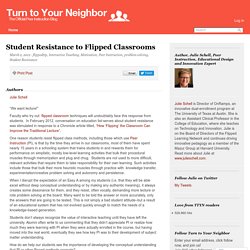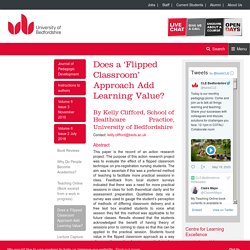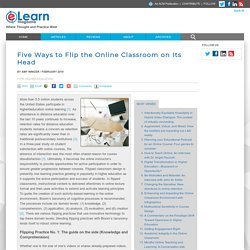

Ed 5968. View of Student experience with e-Portfolio: exploring the roles of trust and creativity. Student Resistance to Flipped Classrooms – Turn to Your Neighbor: The Official Peer Instruction Blog. “We want lecture!”

Faculty who try out flipped classroom techniques will undoubtably face this response from students. In February 2012, conversation on education list-serves about student resistance was stimulated in response to a Chronicle article titled, “How ‘Flipping’ the Classroom Can Improve the Traditional Lecture”. One reason students resist flipped class methods, including those which use Peer Instruction (PI), is that by the time they arrive in our classrooms, most of them have spent nearly 15 years in a schooling system that trains students in and rewards them for performance on simplistic, mostly low-level learning activities that bulk their procedural muscles through memorization and plug and chug.
Students are not used to more difficult, relevant activities that require them to take responsibility for their own learning. Students don’t always recognize the value of interactive teaching until they have left the university. <a href=" target="_blank">Take Our Poll</a> Sal Khan: Let's use video to reinvent education. Strayer inverted classroom influences. Use of teaching methods within the lecture format: Medical Teacher: Vol 14, No 1. ELIR1302 pdf. Cases Flipped Classroom. Strayer inverted classroom influences. ELI7081 pdf. Blended learning. What is blended learning?

Blended approaches use multiple methods to deliver learning by combining face-to-face interactions with online activities. Where did blended learning come from? Blended learning (sometimes referred to as hybrid learning) has a complex heritage that has evolved from the distance and open education movements and the development of online or e-learning. The earliest references to the term ‘blended learning’ are from the late 1990s and since that time definitions of its meaning have varied according to particular combinations of pedagogy and technologies (Friesen 2012). The detail of the ‘blend’ is context specific influenced by institutional culture learner need and is often bounded by the digital capabilities of teachers. Increasing engagement and results with flipped learning - HEA Annual Conference 2017 - Generation TEF: Teaching in the spotlight. Flipping the Classroom.
“Flipping the classroom” has become something of a buzzword in the last several years, driven in part by high profile publications in The New York Times (Fitzpatrick, 2012); The Chronicle of Higher Education (Berrett, 2012); and Science (Mazur, 2009); In essence, “flipping the classroom” means that students gain first exposure to new material outside of class, usually via reading or lecture videos, and then use class time to do the harder work of assimilating that knowledge, perhaps through problem-solving, discussion, or debates.

In terms of Bloom’s revised taxonomy (2001), this means that students are doing the lower levels of cognitive work (gaining knowledge and comprehension) outside of class, and focusing on the higher forms of cognitive work (application, analysis, synthesis, and/or evaluation) in class, where they have the support of their peers and instructor. What is it? 7 Steps to a Flipped Classroom. 10 Pros And Cons Of A Flipped Classroom. 10 Pros And Cons Of A Flipped Classroom by Mike Acedo Many of us can recall instances in our lives where we found ourselves idly sitting in a classroom, eyes glazed over, half listening to our teacher as they lectured in front of the room.

These scenes are all too familiar in today’s schools, as the traditional model of learning has primarily revolved around a teacher-centered classroom, where instructors focus on conveying information, assigning work, and leaving it to the students to master the material. Does a ‘Flipped Classroom’ Approach Add Learning Value? - Journal of Pedagogic Development. Contact: kelly.clifford@beds.ac.uk Abstract This paper is the record of an action research project.

Online focus groups and qualitative research in the social sciences: their merits and limitations in a study of housing and youth. Introduction Focus groups are an established method of collecting research data in the social sciences, bringing together people with mutual characteristics or interests to offer individual and collective insights into particular topics (Morgan, 1996: 130).

Online focus groups capitalise on the increasing use of the internet as a communication tool. They currently take two forms: synchronous, involving real-time live chat comparable to conversational interactions of face-to-face focus groups (Fox et al., 2007), or asynchronous, using ‘static’ text-based communication such as forums and email lists (Gaiser, 1997; Kenny, 2005). Yet, while the use of online focus groups has been discussed in other social sciences such as nursing and health research (Kenny, 2005; Fox et al., 2007; Williams et al., 2012; O’Connor et al., 2014), there has been a lack of discussion as to how they might be applied in disciplines such as social policy, geography, urban studies, and related areas.
References. Insights for conducting real-time focus groups online using a web conferencing service. Ed 5968. MOOC-based flipped learning in higher education: students’ participation, experience and learning performance. Five Ways to Flip the Online Classroom on Its Head. More than 5.5 million students across the United States participate in higher0education online learning [1].

As attendance in distance education over the last 10 years continues to increase, retention rates for distance education students remains a concern as retention rates are significantly lower than in traditional postsecondary institutions [2]. In a three-year study on student satisfaction with online courses, the absence of interaction was the most often shared reason for course dissatisfaction [3]. Ultimately, it becomes the online instructor’s responsibility to provide opportunities for active participation in order to ensure greater progression between courses.
8 Ways to Flip the Classroom for Your Online Course. The traditional classroom structure has teachers delivering lectures during class time, and learners working on problem sets at home.

However, online classes offer instructors a way to reverse that scenario by delivering class lecture content over the Internet, and using class time to work more directly with learners. Ffp0201s. Can You Flip an Online Class? We recently asked a group of teaching assistants, “How do you think today’s college classroom is different than when you were an undergraduate student?

What is the most significant change you’ve noticed?” The number one answer? Technology. This is not a surprise. What’s most interesting is that many of these graduate students were undergraduates just a few years ago, yet they still see technology as the most significant change in the college classroom. Many have argued that education seems to be ‘the last frontier’ for technological disruption (Blin & Munro, 2008; Christensen, C., Aaron, & Clark, 2002; Christensen, 2002; Magid, L., 2013). Getting Student Feedback: Focus Group. Hacking Feedback: Receiving Feedback From Students. Focus Groups for Participatory Action Research.
September Books. Recording Classroom Observations. Center for Education Innovation. In carrying out action research to improve teaching and learning, an important role of the researcher/instructor is to collect data and evidence about the teaching process and student learning.

What follows is an introduction to some of the techniques which can be used for the said purpose. Student Assessment Tests, examinations and continuous assessment can provide valuable data for action research. For your teaching course, you have to set up a method of student assessment and your students have to be assessed, so you might as well make use of it in your project. You should, however, be clear about the nature of the information you can obtain from examination results or assessment grades. LitReview FlippedLearning. Walking the path of desire: evaluating a blended learning approach to developing study skills in a multi-disciplinary group. Development and evaluation of an online learning object to improve pre-registration nursing students' knowledge and engagement with pre-operative fasting. Journal of Learning Development in Higher Education. Engaging Blended Learning Students: An evolving approach to engaging students through the VLE. 'It can't be found in books': how a flipped-classroom approach using online videos can engage postgraduate students in dissertation writing.
Towards a digital Village The Use of Online Social Learning within Higher Education George Charman. Crouch Mazur. Flipped learning.